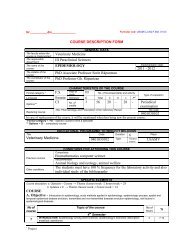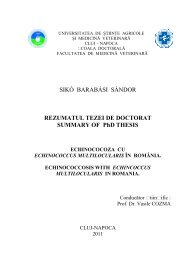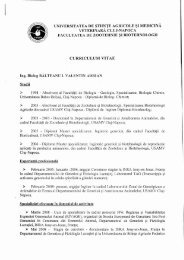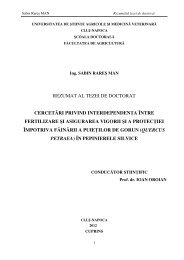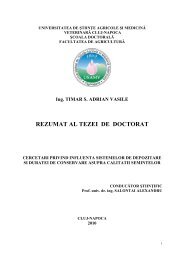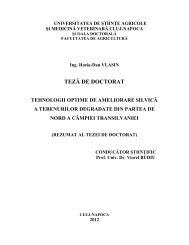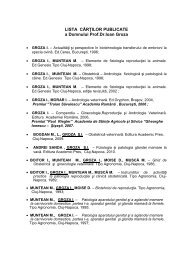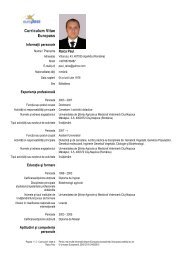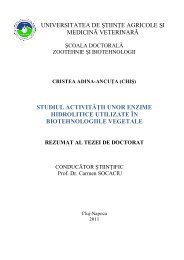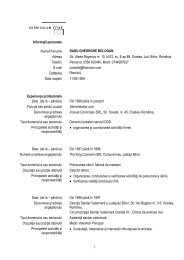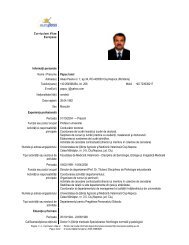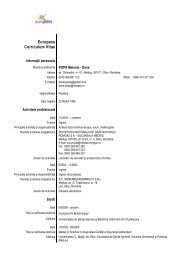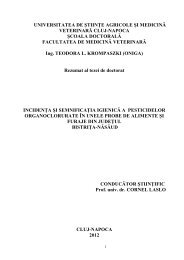Gaitin Dorin [Compatibility Mode] - USAMV Cluj-Napoca
Gaitin Dorin [Compatibility Mode] - USAMV Cluj-Napoca
Gaitin Dorin [Compatibility Mode] - USAMV Cluj-Napoca
Create successful ePaper yourself
Turn your PDF publications into a flip-book with our unique Google optimized e-Paper software.
<strong>Dorin</strong> GAITIN, Ionel SAMFIRA,<br />
Marius BOLDEA, Monica BUTNARIU
Alfalfa is one of the oldest crop plants to be domesticated<br />
domesticated. The first<br />
references to alfalfa show that it was used for forage as much as 3000<br />
years ago. ago It was introduced in Greece in 470 BC as forage plant for<br />
horses and other animals; animals it was then that it received the name<br />
“medica medica”, ”, which, adopted by the Romans, was kept as the name of a<br />
genus genus. genus genus.<br />
The goal of the present research was to study the dynamics, in plain<br />
climatic conditions, of plant height, number of leaves, number of<br />
sprouts, leaf width and length, appearance, dimension and number of<br />
inflorescences, and number of inflorescences per raceme in alfalfa<br />
(Medicago Medicago sativa L.).
In the conditions of a climate with hydric deficit and high<br />
temperatures, common almost every year in the plain area,<br />
it is important to know the dynamics of morpho morpho-productive<br />
productive<br />
features of alfalfa if we need to improve cultivation<br />
technologies and particularly if we need to improve the<br />
species<br />
Present research has pointed out alfalfa cultivars adapted<br />
to environmental conditions, identifying alfalfa adapted to<br />
dry climate conditions associated with high temperatures<br />
temperatures<br />
(a climate that has been more and more common during<br />
the last decade) and alfalfa adapted to the temperate<br />
climate climate.
The alfalfa root<br />
system is very deep<br />
(it can reach up to 2<br />
m in length), which<br />
explains its<br />
particular drought<br />
resistance (almost<br />
the entire root<br />
system is formed in<br />
the first year of<br />
vegetation) .
The biological material was represented by NS Banat ZMS II<br />
variety and mainly morphological features under study were<br />
plant height, number of leaves, number of sprouts, leaf width<br />
and length, the appearance, dimension and number of<br />
inflorescences, and number of inflorescences per raceme raceme. The<br />
biological material was studied in two different locations for a<br />
better knowledge of the dynamics of the morpho-productive<br />
morpho productive<br />
features features. One location was in the low Banat Plain, at the<br />
Didactic Station of Banat University of Agricultural Sciences<br />
and Veterinary Medicine in in Timişoara, on<br />
on a moderately acid soil<br />
of the vertic cambic chernozem type, pH = 5.83 83. For the climatic<br />
characterization, we used data recorded at Timişoara<br />
Meteorological Station in 2010 and 2011. 2011 The other location was<br />
in Mănăştur, the low Vinga Plain, on a phaesiom soil type, pH =<br />
7.53 53. For the climatic characterization, we used data recorded at<br />
Arad Meteorological Station in 2010 and 2011 2011.
The same impact of climate conditions on plant growth is represented in<br />
Figures 3a and 3b for Mănăştur. Mănăştur Thus, there was a height growth of 0.3 cm per<br />
10 mm precipitations, and a height growth of 0.06 06 cm per 10 10°C.<br />
Figure 2a. Plant height growth depending<br />
on precipitations – Timişoara<br />
Figure 2b. Plant height growth depending<br />
on temperature – Timişoara<br />
This allows us to represent proper regression lines. lines Figure 2a shows<br />
regression line and experimental data of height growth depending on<br />
precipitations in Timişoara, i.e. a height growth of 1 cm per 10 mm of<br />
precipitations<br />
precipitations. Figure 2b shows the impact of temperatures on medium height<br />
in the same location, i.e. a height growth of 0.1 cm per 100C. 100<br />
The same impact of climate conditions on plant growth is represented in<br />
Figures 3a and 3b for Mănăştur. Mănăştur Thus, there was a height growth of 0.3 cm per<br />
10 mm precipitations, and a height growth of 0.06 06 cm per 10 10°C.
Figure 3a. Plant height growth depending Figure 3b. Plant height growth depending<br />
on precipitations – Mănăştur<br />
on temperature – Mănăştur<br />
The dynamics of the feature studied, different in different cumulative<br />
values of temperature and precipitations, can be explained by the<br />
location of the crops on soils with different productivity<br />
productivity. We can say<br />
that, of the two types of soil, alfalfa has a growth rate superior in the<br />
moderately acid soil of the vertic cambic chernozem type in Timişoara.<br />
Timişoara
This study is the result of research carried out within the<br />
project ERA 168 168/01 01, titled titled: Sustainable preservation of<br />
indigenous South-East<br />
South East European legumes and their<br />
traditional food and feed products, Sub Project Leader Leader:<br />
Professor Ionel Samfira, U.S.A.M.V.B. in in Timişoara Timişoara.<br />
The authors would also like to thank Mrs Mrs. Viviana Todor,<br />
Manager of the Didactic Experimental Station of the<br />
U.S.A.M.V.B. in Timişoara and Mr Cosmin Micu, Manager of<br />
Procereal Agrosan S.R.L. Mănăştur (Arad County) for<br />
facilitating the sampling of experimental data.<br />
data


![Gaitin Dorin [Compatibility Mode] - USAMV Cluj-Napoca](https://img.yumpu.com/16548383/1/500x640/gaitin-dorin-compatibility-mode-usamv-cluj-napoca.jpg)
